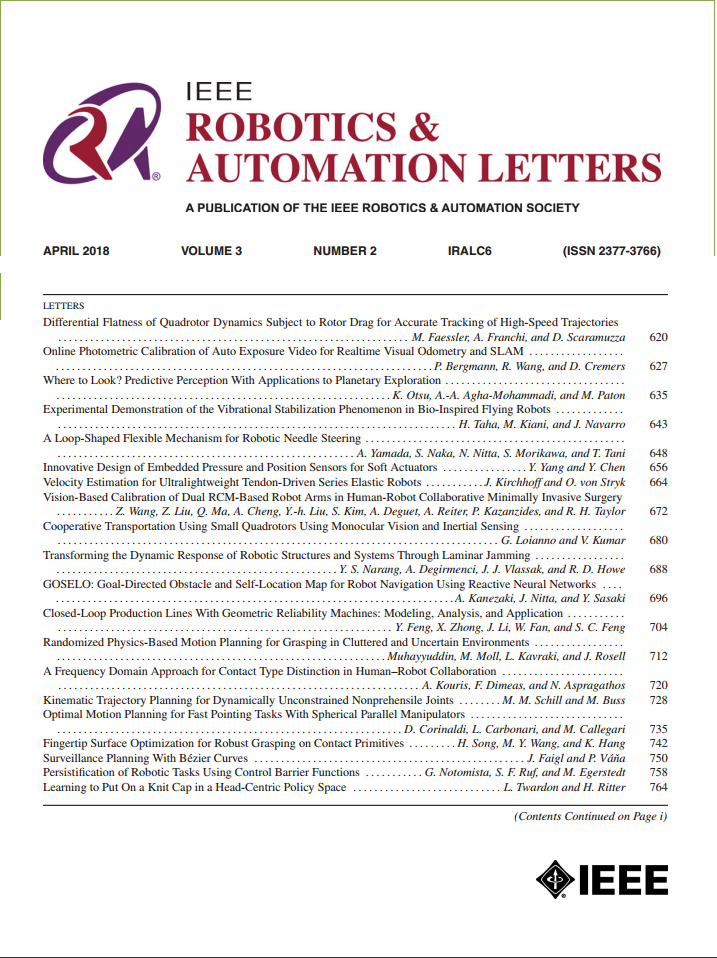REALM: Real-Time Estimates of Assistance for Learned Models in Human-Robot Interaction
IF 4.6
2区 计算机科学
Q2 ROBOTICS
引用次数: 0
Abstract
There are a variety of mechanisms (i.e., input types) for real-time human interaction that can facilitate effective human-robot teaming. For example, previous works have shown how teleoperation, corrective, and discrete (i.e., preference over a small number of choices) input can enable robots to complete complex tasks. However, few previous works have looked at combining different methods, and in particular, opportunities for a robot to estimate and elicit the most effective form of assistance given its understanding of a task. In this letter, we propose a method for estimating the value of different human assistance mechanisms based on the action uncertainty of a robot policy. Our key idea is to construct mathematical expressions for the expected post-interaction differential entropy (i.e., uncertainty) of a stochastic robot policy to compare the expected value of different interactions. As each type of human input imposes a different requirement for human involvement, we demonstrate how differential entropy estimates can be combined with a likelihood penalization approach to effectively balance feedback informational needs with the level of required input. We demonstrate evidence of how our approach interfaces with emergent learning models (e.g., a diffusion model) to produce accurate assistance value estimates through both simulation and a robot user study. Our user study results indicate that the proposed approach can enable task completion with minimal human feedback for uncertain robot behaviors.领域:人机交互中学习模型的实时评估
实时人机交互有多种机制(即输入类型),可以促进有效的人机合作。例如,以前的工作已经表明,远程操作、纠正和离散(即,对少量选择的偏好)输入可以使机器人完成复杂的任务。然而,很少有先前的工作着眼于结合不同的方法,特别是机器人在了解任务的情况下评估和引出最有效的协助形式的机会。在这封信中,我们提出了一种基于机器人政策的行动不确定性来估计不同人类援助机制价值的方法。我们的关键思想是为随机机器人策略的期望交互后微分熵(即不确定性)构建数学表达式,以比较不同交互的期望值。由于每种类型的人类输入对人类参与施加了不同的要求,我们展示了如何将差分熵估计与可能性惩罚方法相结合,以有效地平衡反馈信息需求和所需输入的水平。我们展示了我们的方法如何与紧急学习模型(例如,扩散模型)相结合,通过仿真和机器人用户研究产生准确的辅助价值估计。我们的用户研究结果表明,所提出的方法可以在最小的人类反馈下完成不确定机器人行为的任务。
本文章由计算机程序翻译,如有差异,请以英文原文为准。
求助全文
约1分钟内获得全文
求助全文
来源期刊

IEEE Robotics and Automation Letters
Computer Science-Computer Science Applications
CiteScore
9.60
自引率
15.40%
发文量
1428
期刊介绍:
The scope of this journal is to publish peer-reviewed articles that provide a timely and concise account of innovative research ideas and application results, reporting significant theoretical findings and application case studies in areas of robotics and automation.
 求助内容:
求助内容: 应助结果提醒方式:
应助结果提醒方式:


